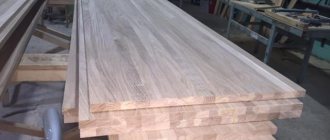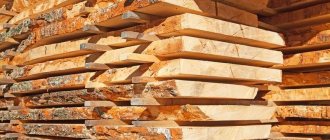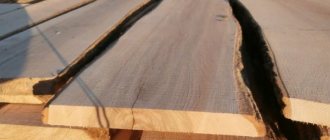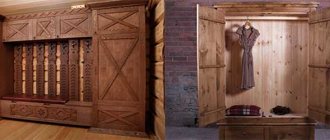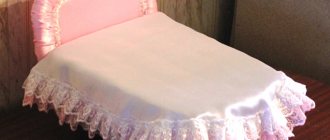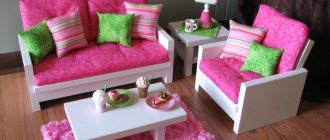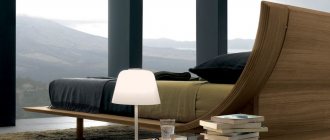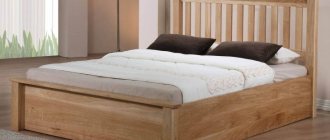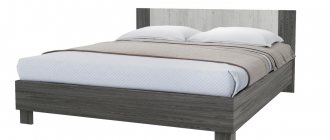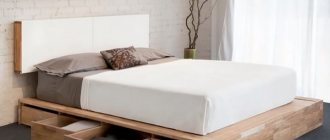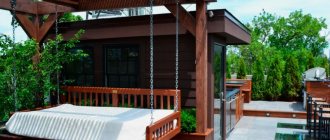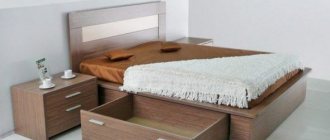Every apartment needs at least a minimum set of furniture to create coziness and comfortable living conditions for a person in it. And this minimum set necessarily includes a sleeping place. Many people choose sofas as a place to sleep, but if the living space allows, it is better to use a bed for this purpose.
It will ensure the highest quality sleep. However, beds are now quite expensive, and purchasing a mattress will increase the financial cost of purchasing one. A homemade bed made from furniture board can significantly help save money . Moreover, making it, as it turned out, is not at all difficult.
Bed made of furniture board
What is a furniture panel?
Homemade beds can be made from various materials, but it is worth noting that most of them use wood and its derivatives as raw materials. This is a natural material that is easy to work with and fully meets all environmental requirements for beds.
One of the wood derivatives is furniture board, which can be bought in a store and used to create home furnishings with your own hands. What is it and how does it differ from the more familiar chipboard or plywood?
Furniture board
So, a furniture panel is a sheet material in the shape of a rectangle or square . To make it, wooden blocks are used, which are planed and glued together during production. The width of one bar can vary between 1-5 cm. The thickness is 18, 28 or 40 mm. The length of each shield varies from 80 cm to 3 m. There are other size variations.
Basically, furniture panels in Russia are made from coniferous trees, but there are also oak and birch. Any of them are suitable for creating homemade beds and other furniture products.
Types of furniture panels - birch, ash, pine, larch, oak
On a note! Furniture board is considered one of the best analogues of chipboard.
The first furniture panels appeared quite a long time ago, but the technology for their production has remained virtually unchanged over the last century. Previously, the bars were simply compressed using clamps, but now pressing is done with special presses - that’s all the difference. High-quality compounds that are safe for humans and nature are used as glue for joining bars. Shields began to be mass produced starting in the 70s of the 20th century.
Furniture board - sheet wood material
Since quite a lot of analogue materials have now appeared, furniture panels are used mainly only in the following cases:
- if it is necessary to comply with high environmental safety standards;
- to create hypoallergenic products;
- for aesthetic purposes - furniture made from furniture panels sometimes looks very beautiful;
- if necessary, get durable and high-quality furniture, since it will last longer than the same furniture made from MDF. And it’s much easier to repair it;
- if you need to obtain a cheap but high-quality product, because the panels are created from wood waste.
Furniture made from furniture board is inexpensive
Furniture panels are sold in stores, packaged in a special film. Thanks to it, it is convenient to transport and store. Now it is a good material, actively used in the production of various furniture. It can also be used to decorate metal entrance doors, as an overlay on them.
Oak furniture panel
Decorative elements
We have already talked about soft headboards, but this is far from the only way to decorate a homemade bed. Now on the market you can make to order or buy ready-made decorative elements for covering beds. This can be a small fragment or a whole carved wooden plate.
This decor looks luxurious, the only problem is that handmade work costs serious money. Alternatively, such plates can be ordered from a furniture workshop and made not from natural wood, but from MDF. There are machines that mill patterns in 3D projection.
Carved decor on a homemade bed looks luxurious.
Advantages and disadvantages
This material has both advantages and disadvantages. So, its advantages include its relatively low cost. For example, furniture board costs much less than the same chipboard. But he is more afraid of moisture. By the way, in the bedroom the air humidity is usually moderate, so it is quite possible to use a furniture panel to make a bed without fear for the fate and condition of the product in the future.
Advantages of furniture panels
If we compare furniture panels with natural solid wood, the latter has higher strength characteristics. But to make a solid wood bed, you will have to spend more money. And the furniture panel, thanks to the high-quality connection of its individual elements, still has fairly good strength. However, it is easier to work with it than with wood, due to its special pliability.
Furniture board has a number of advantages
Also furniture panel:
- able to influence the level of humidity in the room;
- hygienic and looks very beautiful;
- not dangerous to humans;
- can be used for many years.
Most often in the store you can find furniture panels made of pine, which is considered an ideal inexpensive option among other coniferous species. Furniture made from such a panel is often placed in the bathroom or kitchen, as well as in offices and other various rooms.
Pine furniture board
On a note! Pine furniture panels can also be used for the production of interior doors.
If we talk specifically about pine boards, they are considered durable, high-quality, and environmentally friendly. Can also be used for interior decoration. They are inexpensive compared to other shields.
Deciding on the model
In a children's room, several types of beds are most often used:
- With drawers
- Loft bed
- Bunk bed (if there are two kids in the room)
If the room in the children's room does not allow placing a large bed in the room, but you need a compact model that can save square meters, then it is better to choose a design with drawers. Drawers are used to store bedding, toys, children's things and anything that does not fit in a child's chest of drawers or nightstands.
Baby cot on two levels for small children
See alsoDecorative drawings for exclusive do-it-yourself wall decor
Varieties and classifications
A furniture panel may differ not only in the type of wood from which it is made, but also in other parameters, ranging from size to types of joints and a number of other aspects. So, first of all, I would like to note that there are shields:
- solid lamella . Such shields are glued together from bars only along the width. They have a look close to natural wood. Often used for the manufacture of facades and visible elements of interior items;
- spliced _ Such shields can be spliced both along the width and length of the bars. They are cheaper, but are more durable than the first option. Typically used to create not only furniture, but also stairs, window sills and other products.
Types of furniture panel splicing
In neither case do the boards have cracks, defects or other wood defects. The difference in the price of the two types is noticeable, but small and amounts to about 20%.
Shields also have their own classification. Based on this, you can choose the most suitable option in terms of strength and durability.
Table. Classification of furniture panels.
| Class | Characteristics |
| Extra | This is the best furniture board of high quality. It has a so-called solid-lamella fabric, and the bars themselves are very carefully selected taking into account textures and colors. The surface is uniform, smooth and beautiful, there should be no defects. This is the most expensive option for furniture panels. |
| A class | This is a high-quality furniture board with color-matched bars and a smooth, uniform texture. It is slightly inferior in quality to Extra shields, but overall does not have serious deformations. |
| To class | The shield is made from bars spliced along the length and is of worse quality than previous options. There is no clear selection of elements in terms of color and texture. |
| C class | Such a shield usually has quite a lot of flaws, it is uneven in color and texture, and there may be knots on it. The material is not used in its pure form; it must be laminated or veneered, coated with various decorating compounds, etc. |
There are several types of furniture panels
Shields, depending on the type of fusion, may have different sizes, but in general they do not differ from the previously selected standards, which are specified in GOST 13715-78 . Products are manufactured only on the basis of this document. The standard sizes of solid panels vary in thickness and can be 20, 27 and 40 mm, the width of the sheets is 1 m, the length is 2 m. As for jointed panels, their thickness can be 14, 20 and 26 mm, but the width is this is equal to 1210 mm, and the length can be different and vary within 5 m. That is, changes can affect the thickness of the sheet, which simplifies the choice of material.
Varieties, types of furniture panels - photos
On a note! You should not always think that low quality sheets are not suitable for creating furniture. Here everything will depend largely on the final project. Perhaps the material will subsequently be sheathed or painted, then you can buy panels of worse quality. But if the material will not be covered with anything, then it is better to take those shields that have a beautiful texture and surface.
Processing capabilities
Furniture panels can be subjected to various processing methods. These include:
- cutting , that is, cutting into smaller or shaped elements according to the customer’s measurements;
- gluing , when several shields or parts thereof can be joined together;
- brushing or aging wood . This is a fashion trend, and often the panels are artificially aged in order to fit the overall style of the interior;
- Grinding will make the surface of the shield perfectly smooth and even, and get rid of minor surface defects.
Bed made of furniture panels
Furniture panels can also be subjected to other processing and decoration depending on the wishes of the craftsman.
Point No. 3: main frame
| Illustrations | Recommendations |
| Array . To create the frame, a board with a thickness of 30–40 mm and a width of 200 mm is used. Only dry planed wood is used. At the final stages of arrangement, light sanding is allowed to correct minor defects. | |
Mounting holes.
| |
| Chamfer . The chamfer is removed from all frame boards and lightly sanded with sandpaper. | |
| Assembly . The ends of the boards are smeared with wood glue, joined and twisted with self-tapping screws. | |
| Stripping . As assembly proceeds, excess glue will protrude; it is advisable to wipe it off immediately. |
How to make a bed?
Creating a bed from furniture panels is a fairly quick and simple process, and anyone who has at least minimal carpentry skills or wants to master them can handle the task. First of all, you will need to decide on the desired appearance of the bed and, based on this, make a drawing or diagram with all the necessary parameters of the product. This will help calculate the required amount of materials.
Drawing of the future bed
You also need to buy not only furniture panels in the required quantity, but also fittings for them, as well as paint and varnish and other finishing materials. By the way, even at the stage of purchasing shields, you can immediately cut them to the required dimensions - many companies provide such a service for quite little money.
On a note! It is recommended to cover the finished bed with a decorative composition, which will extend the life of the wood and prevent it from losing its beautiful appearance. Also, even before assembling the bed, it is advisable to treat the panels with protective compounds that increase the wood’s resistance to rot and insect attack.
In general, to make a bed you may need the boards and plywood themselves, bars for creating stiffeners, screws and bolts, and metal corners. Of course, you need to get a jigsaw, screwdriver, drill, etc. You can buy a mattress for the bed in advance and, based on its size, make a bed.
Instructions for creating a bed
Let's look at how to make a bed from plywood, furniture boards and bars with a beautiful figured backrest.
Step 1. You need to cut out a pattern for the headboard from a large sheet of paper (it’s best to take old wallpaper). It should be neat and even and meet the wishes of how the headboard should look. The pattern must be attached to a sheet of plywood and traced with a pencil.
The pattern is outlined with a pencil
Step 2. Next, using a jigsaw, you need to cut out the headboard and sand its edges with sandpaper or a sander, rounding them a little.
The edges of the headboard need to be sanded
Finished headboard
Step 3. Then from foam rubber you need to cut out a part of the same shape as the headboard itself, with a small margin, and glue it to the plywood. It is best to make a second part and make the back soft on the reverse side. After this, you can cover the headboard with fabric, making sure that there are no folds. Along the perimeter of the backrest, you can fix and decorate soft materials with decorative nails, repeating the contour of the headboard, stepping back a few centimeters from its edge.
Decorative nails are driven around the perimeter
Step 4. Now you can assemble the bed frame. In this case, all the elements were sawed in advance in the store, but you can cut them out of a furniture panel at home, focusing on the diagram. The frame consists of two side and one end boards; the back will be located at the head. For convenience, you can also make an additional side of the box on the side of the headboard, which will then be attached to the headboard and will not be noticeable. The frame must be joined together using furniture corners and self-tapping screws. For beauty, it can be covered with foam rubber and fabric in the same way as the headboard. From inside the frame, you need to secure a block along its entire perimeter, which will serve as a support for the orthopedic base and mattress. The block must be secured so that the mattress is slightly recessed into the bed (for example, 10 cm).
Assembling the bed frame
Step 5. Now you need to attach the headboard to the bed frame using bolts. Also at this stage, you need to install an additional support beam in the middle of the box, which is fixed using corners on the bed box and must have additional wooden supports below (for the reliability of the product).
The headboard is attached to the frame
There are additional supports at the bottom
Another photo of the process
Step 6. You need to attach and secure the bed legs. In this case, they were purchased at the store, but you can also use homemade ones. They can be fixed at the corners to previously screwed pieces of plywood.
Next, the bed legs are attached
Ready-made legs are used
Step 7. All that remains is to lay the slatted base on the support beams, and place the mattress on top, and the bed is ready. You can sleep on it without fear, as this design is very reliable.
Slatted base installed
Ready-made bed from furniture board
Video - DIY wooden bed (blocks and furniture board)
Point No. 5: fastening the supports for the slatted bottom
| Illustrations | Recommendations |
| Bed side rails. A support beam with a cross-section of at least 50x50 mm is attached to the side ironing of the box. The bars are fixed in the same way as the box, that is, through inclined holes on self-tapping screws. | |
| Glue mounting . In addition to self-tapping screws, the bars are placed on glue. In order for the glue to set over the entire plane, the structure is tightened with clamps. | |
| Legs . Everyone determines the height of the legs independently. For manufacturing, a beam with a cross section of 100x100 mm is taken. | |
| Installation of legs . The legs are screwed with self-tapping screws along the corners of the box to the supporting horizontal bars. | |
| Reiki . The mattress will be placed on the slatted tray. A 100x20 mm planed board is used as slats; the board is fixed with self-tapping screws. A ventilation gap of 50 mm is left between the slats. |
